英语感官动词用法大全!
英语感官动词造句
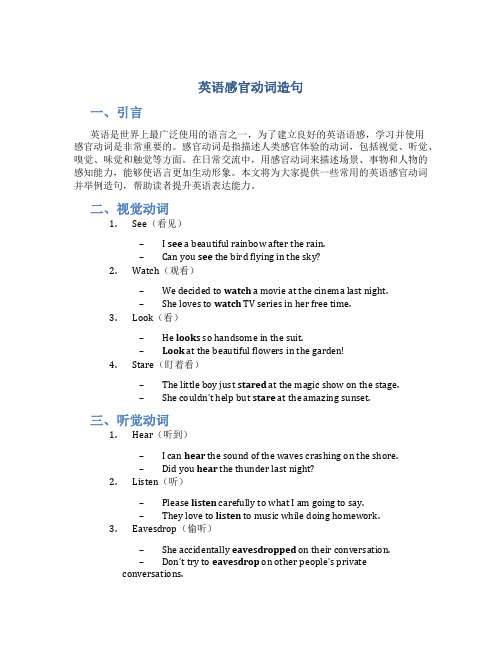
英语感官动词造句一、引言英语是世界上最广泛使用的语言之一,为了建立良好的英语语感,学习并使用感官动词是非常重要的。
感官动词是指描述人类感官体验的动词,包括视觉、听觉、嗅觉、味觉和触觉等方面。
在日常交流中,用感官动词来描述场景、事物和人物的感知能力,能够使语言更加生动形象。
本文将为大家提供一些常用的英语感官动词并举例造句,帮助读者提升英语表达能力。
二、视觉动词1.See(看见)–I see a beautiful rainbow after the rain.–Can you see the bird flying in the sky?2.Watch(观看)–We decided to watch a movie at the cinema last night.–She loves to watch TV series in her free time.3.Look(看)–He looks so handsome in the suit.–Look at the beautiful flowers in the garden!4.Stare(盯着看)–The little boy just stared at the magic show on the stage.–She couldn’t help but stare at the amazing sunset.三、听觉动词1.Hear(听到)–I can hear the sound of the waves crashing on the shore.–Did you hear the thunder last night?2.Listen(听)–Please listen carefully to what I am going to say.–They love to listen to music while doing homework.3.Eavesdrop(偷听)–She accidentally eavesdropped on their conversation.–Don’t try to eavesdrop on other people’s privateconversations.4.Overhear(无意中听到)–I overheard him talking about his travel plans.–They were shocked when they overheard their neighbors arguing.四、嗅觉动词1.Smell(闻)–I love the smell of freshly baked bread.–Can you smell the scent of flowers in the garden?2.Sniff(嗅)–The dog sniffed around the room, searching for food.–She sniffed the perfume to see if she liked it.3.Scent(嗅到)–The hunter could sense the scent of the prey nearby.–The bakery is filled with the scent of freshly brewed coffee.4.Inhale(吸入)–She closed her eyes and inhaled the refreshing ocean breeze.–It’s important to inhale deeply when practicing yoga.五、味觉动词1.Taste(尝)–The soup tastes very delicious.–Have you tasted the new flavor of ice cream?2.Try(尝试)–He decided to try the spicy food even though he couldn’t handle it.–Don’t forget to try the local cuisine when you travel.3.Savor(品味)–She savored every bite of the chocolate cake.–Take your time to savor the flavors of the dish.4.Sample(品尝)–The waiter offered to sample the different wines before ordering.–They sampled various types of cheese during the tasting event.六、触觉动词1.Touch(触摸)–The soft fur made her want to touch the cute little puppy.–She hesitated to touch the prickly cactus.2.Feel(感受)–We all feel excited about the upcoming vacation.–Can you feel the warmth of the sun on your skin?3.Hold(握住)–He gently held her hand as they walked along the beach.–The child held the balloon tightly, afraid of letting it go.4.Embrace(拥抱)–They finally met after a long time and shared a warm embrace.–The mother embraced her child tightly to show her love.七、结论通过运用感官动词,我们可以更加生动地描述我们与世界的感知和互动。
英语中感官动词的用法
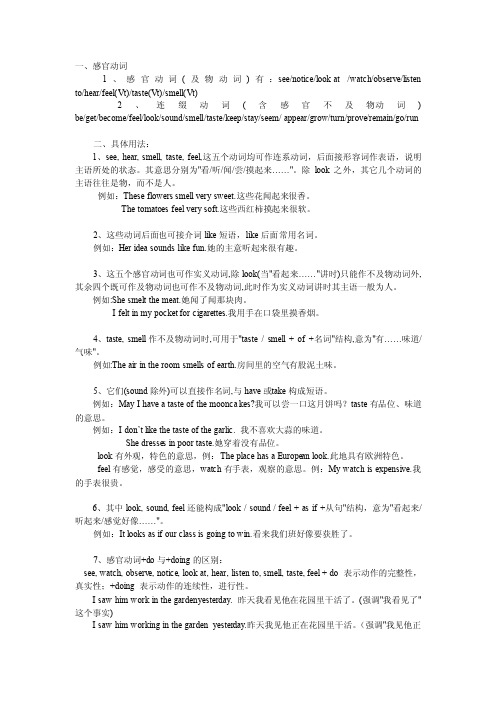
一、感官动词1、感官动词(及物动词)有:see/notice/look at/watch/observe/listento/hear/feel(Vt)/taste(Vt)/smell(Vt)2、连缀动词(含感官不及物动词) be/get/become/feel/look/sound/smell/taste/keep/stay/seem/ appear/grow/turn/prove/remain/go/run二、具体用法:1、see, hear, smell, taste, feel,这五个动词均可作连系动词,后面接形容词作表语,说明主语所处的状态。
其意思分别为"看/听/闻/尝/摸起来……"。
除look之外,其它几个动词的主语往往是物,而不是人。
例如:These flowers smell very sweet.这些花闻起来很香。
The tomatoe s feel very soft.这些西红柿摸起来很软。
2、这些动词后面也可接介词li ke短语,like后面常用名词。
例如:Her idea soundslike fun.她的主意听起来很有趣。
3、这五个感官动词也可作实义动词,除look(当"看起来……"讲时)只能作不及物动词外,其余四个既可作及物动词也可作不及物动词,此时作为实义动词讲时其主语一般为人。
例如:She smelt the meat.她闻了闻那块肉。
I felt in my pocketfor cigaret tes.我用手在口袋里摸香烟。
4、taste, smell作不及物动词时,可用于"taste / smell + of +名词"结构,意为"有……味道/气味"。
例如:The air in the room smellsof earth.房间里的空气有股泥土味。
感官动词的用法
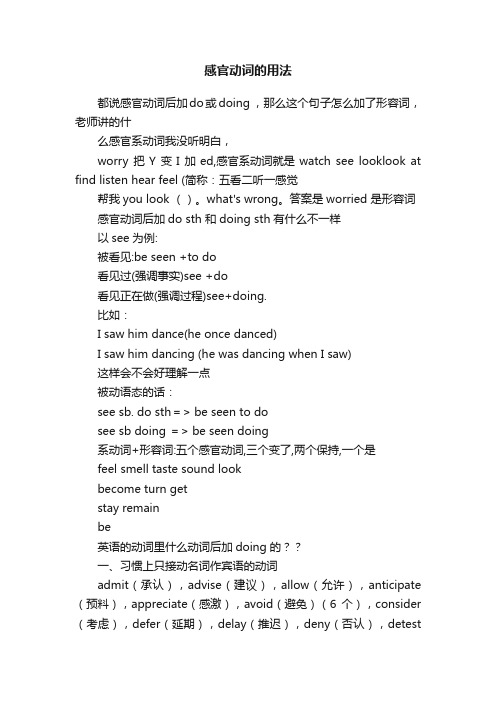
感官动词的用法都说感官动词后加do或doing ,那么这个句子怎么加了形容词,老师讲的什么感官系动词我没听明白,worry 把Y 变I 加ed,感官系动词就是watch see looklook at find listen hear feel (简称:五看二听一感觉帮我you look ()。
what's wrong。
答案是worried 是形容词感官动词后加do sth 和doing sth有什么不一样以see为例:被看见:be seen +to do看见过(强调事实)see +do看见正在做(强调过程)see+doing.比如:I saw him dance(he once danced)I saw him dancing (he was dancing when I saw)这样会不会好理解一点被动语态的话:see sb. do sth=> be seen to dosee sb doing => be seen doing系动词+形容词:五个感官动词,三个变了,两个保持,一个是feel smell taste sound lookbecome turn getstay remainbe英语的动词里什么动词后加doing的??一、习惯上只接动名词作宾语的动词admit(承认),advise(建议),allow(允许),anticipate (预料),appreciate(感激),avoid(避免)(6个),consider (考虑),defer(延期),delay(推迟),deny(否认),detest(讨厌),discuss(讨论),dislike(不喜欢),dread(担心)(七个),enjoy(喜爱),escape(逃脱),excuse(原谅),fancy(设想),finish(完成),forbid(禁止),forgive(原谅),imagine (想像),keep(保持),loathe(厌恶),mention(提及),mind(介意),miss(没赶上),pardon(原谅),permit (允许),practice(练习),prevent(阻止),prohibit(禁止),propose(建议),7个recollect(记得),report(报告),resent(愤恨),resist(抵制),risk(冒险)五个,stand(容忍),stop(停止,阻止),suggest(提议),understand(理解)二、接动名词或不定式作宾语且意义相差不大的动词like(喜欢),love(喜欢),hate(憎恨),prefer(宁可),begin(开始),start(开始),continue(继续),can’t bear (不能忍受),bother(麻烦),intend(想要),cease (停止)三、接动名词或者不定式作宾语但意义不同的动词接动名词或者不定式作宾语但意义不同的动词1、remember(记得),forget(忘记),regret(后悔),stop(停止)(1)后接不定式时指该不定式所表示的动作后发生。
高考感官动词用法总结

高考感官动词用法总结在高考英语中,感官动词是一个重要的语法点。
掌握好感官动词的用法,对于理解和运用英语语言有着重要的意义。
下面我们就来详细总结一下高考中常见的感官动词用法。
一、常见的感官动词常见的感官动词有:see(看见)、watch(观看)、look at(看)、hear(听见)、listen to(听)、feel(感觉)、smell(闻)、taste(尝)等。
二、感官动词的用法1、感官动词+宾语+宾语补足语(1)感官动词+宾语+ do(表示动作的全过程,强调结果或经常性的动作)例如:I saw him cross the road(我看见他过了马路。
)We often hear her sing in the room(我们经常听见她在房间里唱歌。
)(2)感官动词+宾语+ doing(表示动作正在进行)例如:I saw him crossing the road when I passed by(我路过时看见他正在过马路。
)I heard her singing in the room at that time(那时我听见她正在房间里唱歌。
)(3)感官动词+宾语+ done(表示宾语与宾语补足语之间是被动关系)例如:I saw the window broken(我看见窗户被打破了。
)We found the tree cut down(我们发现树被砍倒了。
)2、感官动词+宾语从句例如:I saw that he crossed the road safely(我看见他安全地过了马路。
)She heard that someone was knocking at the door(她听见有人在敲门。
)3、感官动词的被动语态感官动词在被动语态中,其后的宾语补足语要用带 to 的不定式。
例如:He was seen to cross the road(有人看见他过了马路。
)The girl was heard to sing in the room(有人听见这个女孩在房间里唱歌。
初中英语感官动词的用法
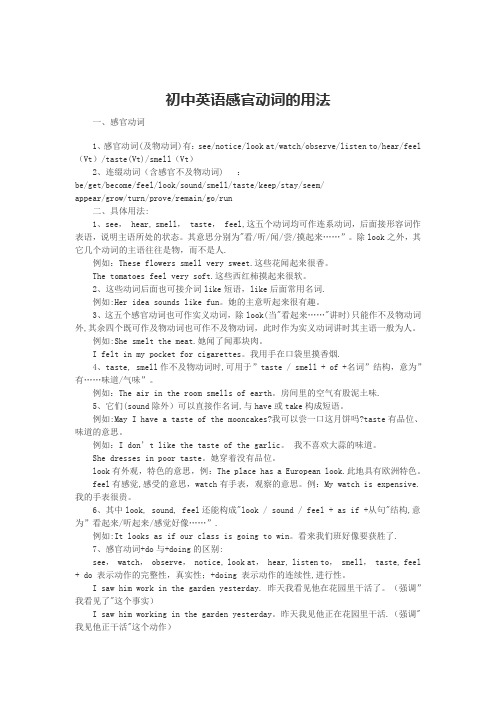
初中英语感官动词的用法一、感官动词1、感官动词(及物动词)有:see/notice/look at/watch/observe/listen to/hear/feel (Vt)/taste(Vt)/smell(Vt)2、连缀动词(含感官不及物动词) :be/get/become/feel/look/sound/smell/taste/keep/stay/seem/appear/grow/turn/prove/remain/go/run二、具体用法:1、see, hear, smell, taste, feel,这五个动词均可作连系动词,后面接形容词作表语,说明主语所处的状态。
其意思分别为"看/听/闻/尝/摸起来……”。
除look之外,其它几个动词的主语往往是物,而不是人.例如:These flowers smell very sweet.这些花闻起来很香。
The tomatoes feel very soft.这些西红柿摸起来很软。
2、这些动词后面也可接介词like短语,like后面常用名词.例如:Her idea sounds like fun。
她的主意听起来很有趣。
3、这五个感官动词也可作实义动词,除look(当"看起来……"讲时)只能作不及物动词外,其余四个既可作及物动词也可作不及物动词,此时作为实义动词讲时其主语一般为人。
例如:She smelt the meat.她闻了闻那块肉。
I felt in my pocket for cigarettes。
我用手在口袋里摸香烟.4、taste, smell作不及物动词时,可用于”taste / smell + of +名词”结构,意为”有……味道/气味”。
例如:The air in the room smells of earth。
房间里的空气有股泥土味.5、它们(sound除外)可以直接作名词,与have或take构成短语。
英语中的感官动词的用法
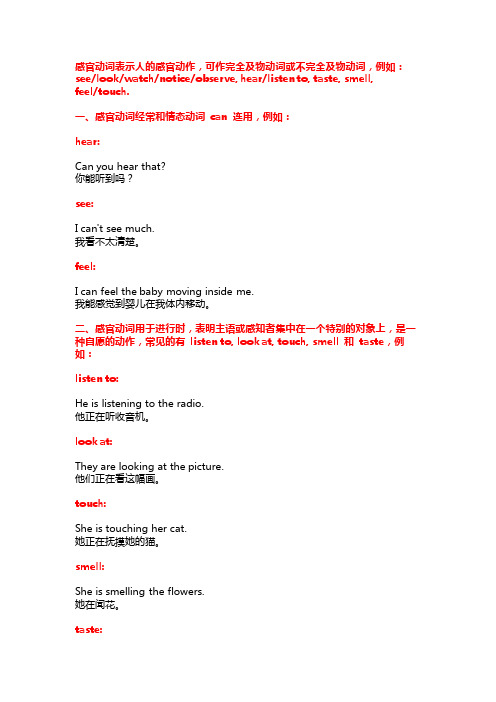
感官动词表示人的感官动作,可作完全及物动词或不完全及物动词,例如:see/look/watch/notice/observe, hear/listen to, taste, smell,feel/touch.一、感官动词经常和情态动词can 连用,例如:hear:Can you hear that?你能听到吗?see:I can't see much.我看不太清楚。
feel:I can feel the baby moving inside me.我能感觉到婴儿在我体内移动。
二、感官动词用于进行时,表明主语或感知者集中在一个特别的对象上,是一种自愿的动作,常见的有listen to, look at, touch, smell 和taste,例如:listen to:He is listening to the radio.他正在听收音机。
look at:They are looking at the picture.他们正在看这幅画。
touch:She is touching her cat.她正在抚摸她的猫。
smell:She is smelling the flowers.她在闻花。
taste:We are tasting champagne.我们正在品尝香槟。
并不是所有的感官动词都可以用进行时,例如:误:She was hearing a noise.误:He was seeing a woman in the rain.但当hear 在表达一种经历时,可以用进行时;see 在表达与人见面或是约会,可以用进行时,等等,例如:hearing:She was always hearing voices in her head.她脑子里总有声音。
seeing:She is seeing the doctor.她正在看医生。
He was seeing another woman.他在和另一个女人约会。
英语中感官动词的用法
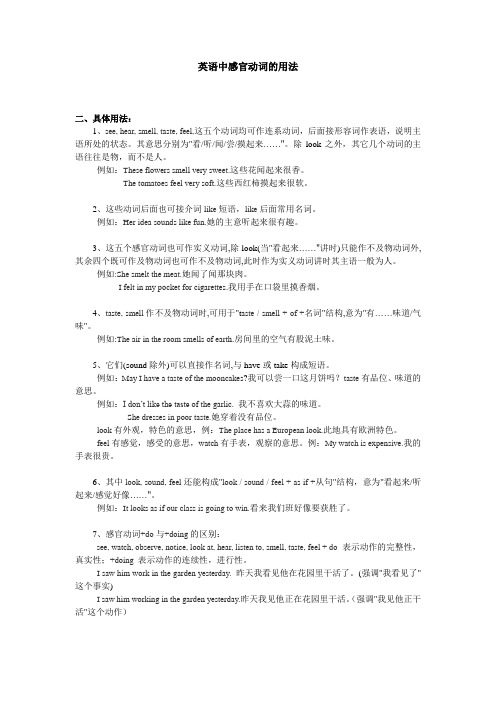
英语中感官动词的用法二、具体用法:1、see, hear, smell, taste, feel,这五个动词均可作连系动词,后面接形容词作表语,说明主语所处的状态。
其意思分别为"看/听/闻/尝/摸起来……"。
除look之外,其它几个动词的主语往往是物,而不是人。
例如:These flowers smell very sweet.这些花闻起来很香。
The tomatoes feel very soft.这些西红柿摸起来很软。
2、这些动词后面也可接介词like短语,like后面常用名词。
例如:Her idea sounds like fun.她的主意听起来很有趣。
3、这五个感官动词也可作实义动词,除look(当"看起来……"讲时)只能作不及物动词外,其余四个既可作及物动词也可作不及物动词,此时作为实义动词讲时其主语一般为人。
例如:She smelt the meat.她闻了闻那块肉。
I felt in my pocket for cigarettes.我用手在口袋里摸香烟。
4、taste, smell作不及物动词时,可用于"t aste / smell + of +名词"结构,意为"有……味道/气味"。
例如:The air in the room smells of earth.房间里的空气有股泥土味。
5、它们(sound除外)可以直接作名词,与have或take构成短语。
例如:May I have a taste of the mooncakes?我可以尝一口这月饼吗?taste有品位、味道的意思。
例如:I don’t like the taste of the garlic.我不喜欢大蒜的味道。
She dresses in poor taste.她穿着没有品位。
look有外观,特色的意思,例:The place has a European look.此地具有欧洲特色。
感官动词的用法

感官动词1.see, hear, listen to, watch, notice等词,后接宾语,再接省略to的动词不定式或ing 形式。
前者表全过程,后者表正在进行。
句中有频率词时,以上的词也常跟动词原形。
注释:省略to的动词不定式--to do是动词不定式,省略了to,剩下do,其形式和动词原形是一样的,但说法不同。
see sb do sth 看到某人做了某事see sb doing sth 看到某人在做某事hear sb do sth 听到某人做了某事hear sb doing sth 听到某人在做某事以此类推...I heard someone knocking at the door when I fell asleep. (我入睡时有人正敲门,强调当时正在敲门)I heard someone knock at the door three times. (听到有人敲门的全过程)I often watch my classmates play volleyball after school. (此处有频率词often)(了解)若以上词用于被动语态,须将省略的to还原:see sb do sth----sb be seen to do sthhear sb do sth----sb be seen to do sth以此类推...We saw him go into the restaurant. → He was seen to go into the restaurant.I hear the boy cry every day. → The boy is heard to cry every day.2.感官动词look, sound, smell, taste, feel可当系动词,后接形容词。
He looks angry.His explanation sounds reasonable.The cakes smell nice.The dishes taste delicious.The silk feels smooth.注意:如果加介词like构成词组,则后不可接形容词,而接名词或代词:sound like 听起来像...look like 看起来像...He looks like his mother.That sounds like a good idea.It sounds like great fun.It smells like a flower.It tastes like salt.3.如何判断look是实义动词还是感官动词?当look理解为"看起来"时,是感官动词,后接形容词.The naughty boys broke the window.The teacher looked angry.当look理解为"看"或者与其它词构成词组时,是实义动词,需要用副词修饰. The teacher looked anrily at the naughty boys.。
在英语中感官动词用法?
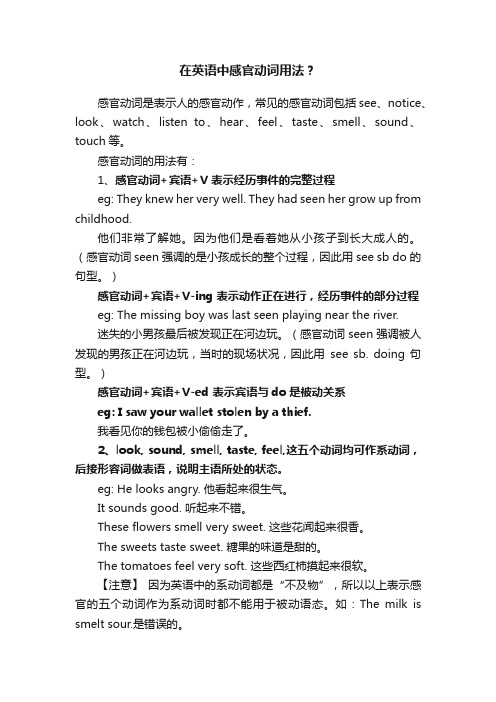
在英语中感官动词用法?感官动词是表示人的感官动作,常见的感官动词包括see、notice、look、watch、listen to、hear、feel、taste、smell、sound、touch等。
感官动词的用法有:1、感官动词+宾语+V 表示经历事件的完整过程eg: They knew her very well. They had seen her grow up from childhood.他们非常了解她。
因为他们是看着她从小孩子到长大成人的。
(感官动词seen强调的是小孩成长的整个过程,因此用see sb do 的句型。
)感官动词+宾语+V-ing 表示动作正在进行,经历事件的部分过程eg: The missing boy was last seen playing near the river.迷失的小男孩最后被发现正在河边玩。
(感官动词seen强调被人发现的男孩正在河边玩,当时的现场状况,因此用see sb. doing 句型。
)感官动词+宾语+V-ed 表示宾语与do是被动关系eg: I saw your wallet stolen by a thief.我看见你的钱包被小偷偷走了。
2、look, sound, smell, taste, feel,这五个动词均可作系动词,后接形容词做表语,说明主语所处的状态。
eg: He looks angry. 他看起来很生气。
It sounds good. 听起来不错。
These flowers smell very sweet. 这些花闻起来很香。
The sweets taste sweet. 糖果的味道是甜的。
The tomatoes feel very soft. 这些西红柿摸起来很软。
【注意】因为英语中的系动词都是“不及物”,所以以上表示感官的五个动词作为系动词时都不能用于被动语态。
如:The milk is smelt sour.是错误的。
高中英语感官动词的用法
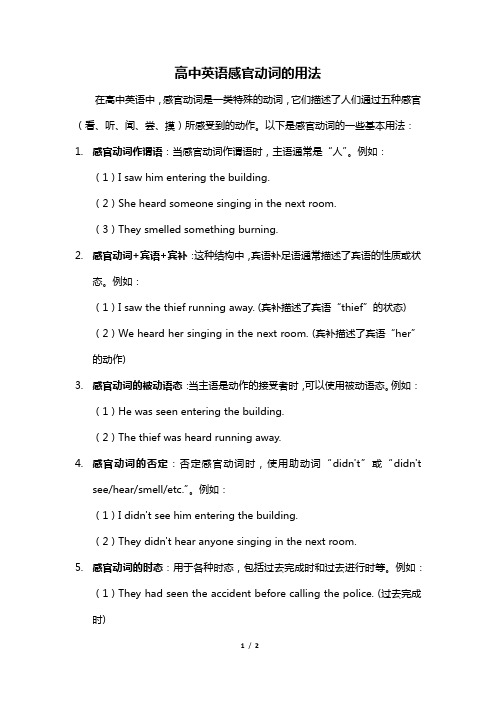
高中英语感官动词的用法在高中英语中,感官动词是一类特殊的动词,它们描述了人们通过五种感官(看、听、闻、尝、摸)所感受到的动作。
以下是感官动词的一些基本用法:1.感官动词作谓语:当感官动词作谓语时,主语通常是“人”。
例如:(1)I saw him entering the building.(2)She heard someone singing in the next room.(3)They smelled something burning.2.感官动词+宾语+宾补:这种结构中,宾语补足语通常描述了宾语的性质或状态。
例如:(1)I saw the thief running away. (宾补描述了宾语“thief”的状态) (2)We heard her singing in the next room. (宾补描述了宾语“her”的动作)3.感官动词的被动语态:当主语是动作的接受者时,可以使用被动语态。
例如:(1)He was seen entering the building.(2)The thief was heard running away.4.感官动词的否定:否定感官动词时,使用助动词“didn't”或“didn'tsee/hear/smell/etc.”。
例如:(1)I didn't see him entering the building.(2)They didn't hear anyone singing in the next room.5.感官动词的时态:用于各种时态,包括过去完成时和过去进行时等。
例如:(1)They had seen the accident before calling the police. (过去完成时)(2)She was seeing a movie when the power went out. (过去进行时) 高中英语中的感官动词主要用于描述人们通过五感所感知到的动作和状态。
中考英语感官动词用法
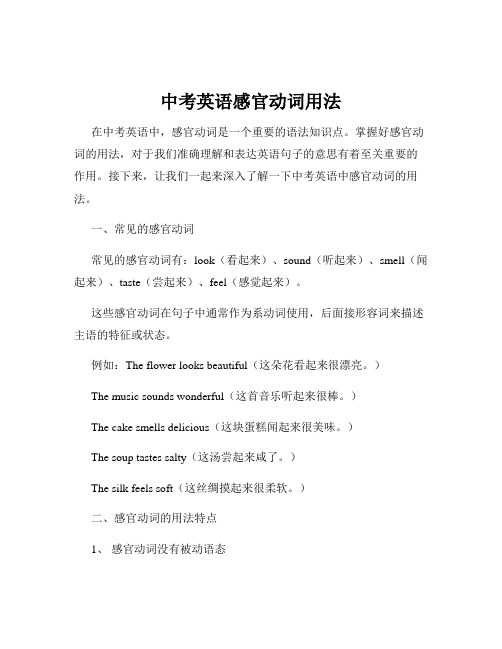
中考英语感官动词用法在中考英语中,感官动词是一个重要的语法知识点。
掌握好感官动词的用法,对于我们准确理解和表达英语句子的意思有着至关重要的作用。
接下来,让我们一起来深入了解一下中考英语中感官动词的用法。
一、常见的感官动词常见的感官动词有:look(看起来)、sound(听起来)、smell(闻起来)、taste(尝起来)、feel(感觉起来)。
这些感官动词在句子中通常作为系动词使用,后面接形容词来描述主语的特征或状态。
例如:The flower looks beautiful(这朵花看起来很漂亮。
)The music sounds wonderful(这首音乐听起来很棒。
)The cake smells delicious(这块蛋糕闻起来很美味。
)The soup tastes salty(这汤尝起来咸了。
)The silk feels soft(这丝绸摸起来很柔软。
)二、感官动词的用法特点1、感官动词没有被动语态因为感官动词所表达的是人的主观感受,不是被动接受的动作,所以没有被动语态。
例如:不能说“The flower is looked beautiful by me” 而只能说“The flower looks beautiful”2、感官动词后接形容词,而不是副词这是感官动词的一个重要特点,很多同学容易在这里犯错。
比如:要说“He looks happy” 而不是“He looks happily”3、感官动词+like +名词表示“看起来像”例如:She looks like her mother(她看起来像她的母亲。
)三、感官动词的句型结构1、主语+感官动词+形容词这是最基本的句型结构,表示主语给人的某种感觉。
例如:The dress feels smooth(这件连衣裙摸起来很光滑。
)2、主语+感官动词+ like +名词/代词这个句型表示“主语看起来像”例如:The cloud looks like a dog(那朵云看起来像一只狗。
感官动词的用法归纳
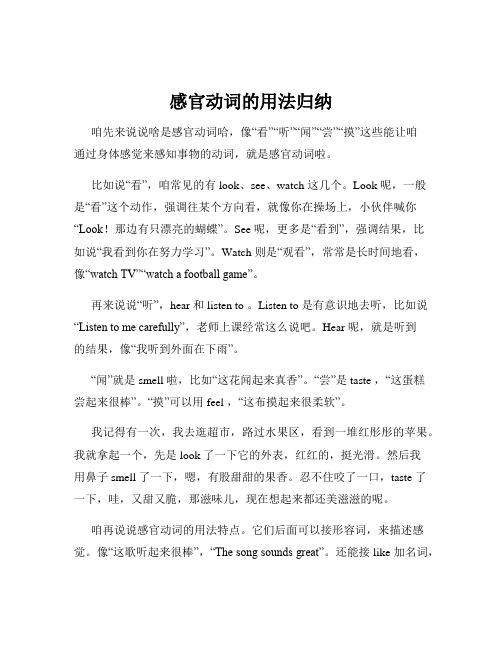
感官动词的用法归纳咱先来说说啥是感官动词哈,像“看”“听”“闻”“尝”“摸”这些能让咱通过身体感觉来感知事物的动词,就是感官动词啦。
比如说“看”,咱常见的有 look、see、watch 这几个。
Look 呢,一般是“看”这个动作,强调往某个方向看,就像你在操场上,小伙伴喊你“Look!那边有只漂亮的蝴蝶”。
See 呢,更多是“看到”,强调结果,比如说“我看到你在努力学习”。
Watch 则是“观看”,常常是长时间地看,像“watch TV”“watch a football game”。
再来说说“听”,hear 和 listen to 。
Listen to 是有意识地去听,比如说“Listen to me carefully”,老师上课经常这么说吧。
Hear 呢,就是听到的结果,像“我听到外面在下雨”。
“闻”就是 smell 啦,比如“这花闻起来真香”。
“尝”是 taste ,“这蛋糕尝起来很棒”。
“摸”可以用 feel ,“这布摸起来很柔软”。
我记得有一次,我去逛超市,路过水果区,看到一堆红彤彤的苹果。
我就拿起一个,先是 look 了一下它的外表,红红的,挺光滑。
然后我用鼻子 smell 了一下,嗯,有股甜甜的果香。
忍不住咬了一口,taste 了一下,哇,又甜又脆,那滋味儿,现在想起来都还美滋滋的呢。
咱再说说感官动词的用法特点。
它们后面可以接形容词,来描述感觉。
像“这歌听起来很棒”,“The song sounds great”。
还能接 like 加名词,表示“看起来/听起来/闻起来/尝起来/摸起来像……”,比如说“她看起来像个明星”“She looks like a star”。
还有哦,感官动词有时会用进行时态,表示“正在……”的意思。
比如说“我正在看电影”“I'm watching a film”。
在做题的时候,大家可要注意分辨这些感官动词的细微差别,别搞混啦。
比如说,“我听到有人在敲门”,就得用 hear ,要是用 listen to 可就不对啦。
感官动词详解

感官动词详解学习英语怎么能不知道感官动词呢?下面就让店铺为大家详解一下吧。
1.感官动词表示人的感官动作,可作完全及物动词或不完全及物动词,如:listen to(听),hear(听见),see(看见),watch(观看),feel (感觉)等。
Darling, did you hear something?亲爱的,你听到什么了吗?Have you heard the news?你听到这消息了吗?感官动词 heard作完全及物动词。
2.感官动词作不完全及物动词时,后接宾语,再接原形不定词或分词作宾语补语。
But I really heard someone steal.但我真听见有人在偷东西。
I heard her sing.我听见她唱歌。
感官动词后接原形不定词强调事实。
I heard someone opening the cabinet.我听见有人在开柜子。
I heard her singing.我听见有人在唱歌。
感官动词后接现在分词强调动作正在进行。
3.感官动词的被动语态的宾语补语用不定词或现在分词。
Someone was heard to open the cabinet by us.我们听到有人开柜子。
She was heard to sing in the concert.人们听到她在音乐会上演唱。
不定词强调事实。
She was heard singing last night.有人听到她昨天晚上在唱歌。
现在分词强调动作的'进行。
4.感官动词表示被动含义时,不能用于进行时态;感官动词表示主动含义可以用于进行式。
hear, see通常分别以其相应意义的介系词动词 listen to,look at的进行式来代替。
I feel some fruit juices on the soles of my feet.我感觉到我脚底有果汁。
I feel a pin in it somewhere.我感觉到这里什么地方有一根针。
感官动词详解

1. hear/see/watch/look at/listen to sb. doing sth.意为“听见/看见/发现/看/听某人正在做某事”。
动作正在进行。
eg ▲I heard the girl playing the piano at this time yesterday.我昨天这个时候听见这个女孩正在弹钢琴。
▲I saw him playing football on the playground just now.刚才我看见他正在操场上踢足球。
▲He stopped to watch us working.他停下来看我们干活。
▲The father looked at his son writing.那位父亲看着儿子写字。
▲Did you listen to them singing then? 你当时听他们唱歌了吗?I saw them playing football on the playground.我看到他们在操场上踢球。
2. hear/see/notice/watch sb. do sth.意为“听见/看见/发现某人做某事”。
do表示多次动作、反复发生的动作或动作全过程。
eg I saw him come into the classroom.我看到他走进了教室。
▲I often hear the girl play the piano in the next room.我常常听见这个女孩在隔壁弹钢琴。
▲Over the years, we've seen musical groups with pretty strange names come and go.几年期间,我们已经看见有着非常奇怪名字的乐队来来去去。
▲I watched them get into the car.我看着他们上了车。
感官动词see/watch/look at/hear/listento/notice sb等其后可以接两种结构do/doing sth.它们的含义有什么不同呢?我们一起来看看!(1)see/watch/hear/notice + sb.+ do sth. “看到/听到/注意到某人做某事”,do sth.指动作的全过程,强调结果。
初二感官动词的用法
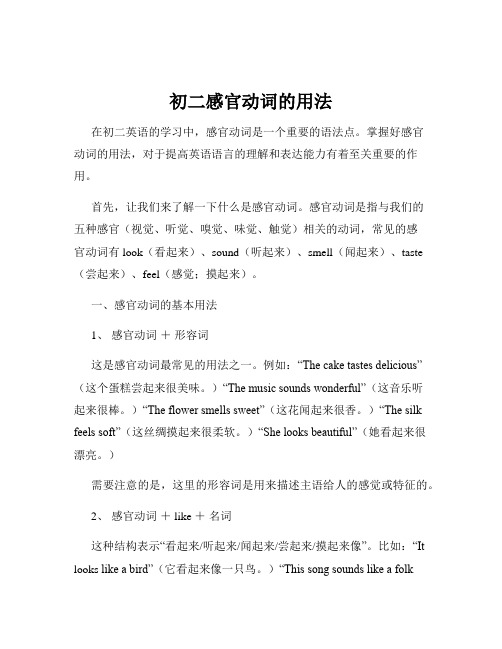
初二感官动词的用法在初二英语的学习中,感官动词是一个重要的语法点。
掌握好感官动词的用法,对于提高英语语言的理解和表达能力有着至关重要的作用。
首先,让我们来了解一下什么是感官动词。
感官动词是指与我们的五种感官(视觉、听觉、嗅觉、味觉、触觉)相关的动词,常见的感官动词有 look(看起来)、sound(听起来)、smell(闻起来)、taste (尝起来)、feel(感觉;摸起来)。
一、感官动词的基本用法1、感官动词+形容词这是感官动词最常见的用法之一。
例如:“The cake tastes delicious”(这个蛋糕尝起来很美味。
)“The music sounds wonderful”(这音乐听起来很棒。
)“The flower smells sweet”(这花闻起来很香。
)“The silk feels soft”(这丝绸摸起来很柔软。
)“She looks beautiful”(她看起来很漂亮。
)需要注意的是,这里的形容词是用来描述主语给人的感觉或特征的。
2、感官动词+ like +名词这种结构表示“看起来/听起来/闻起来/尝起来/摸起来像”。
比如:“It looks like a bird”(它看起来像一只鸟。
)“This song sounds like a folksong”(这首歌听起来像一首民歌。
)“The dish smells like fish”(这道菜闻起来像鱼。
)“The drink tastes like juice”(这饮料尝起来像果汁。
)“The stone feels like a ball”(这块石头摸起来像一个球。
)二、感官动词的实义动词用法1、 look当 look 表示“看;瞧”这一实义动作时,其后要接宾语,通常要与介词 at 连用。
例如:“Look at the blackboard, please”(请看黑板。
)2、 feelfeel 作为实义动词时,可以表示“触摸;摸索”等意思。
英语感官动词的用法
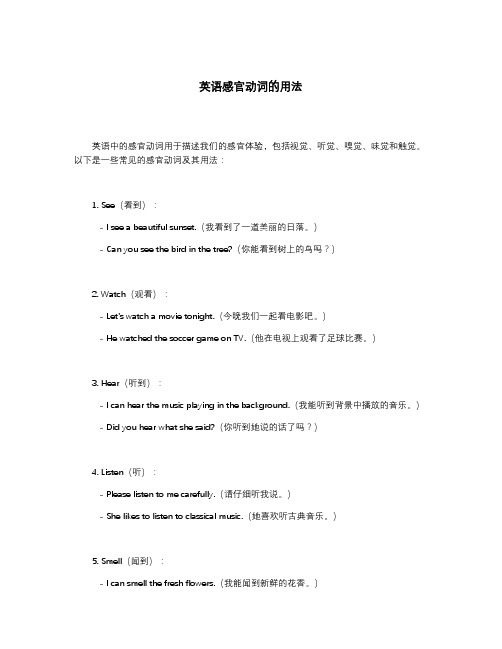
英语感官动词的用法英语中的感官动词用于描述我们的感官体验,包括视觉、听觉、嗅觉、味觉和触觉。
以下是一些常见的感官动词及其用法:1. See(看到):- I see a beautiful sunset.(我看到了一道美丽的日落。
)- Can you see the bird in the tree?(你能看到树上的鸟吗?)2. Watch(观看):- Let's watch a movie tonight.(今晚我们一起看电影吧。
)- He watched the soccer game on TV.(他在电视上观看了足球比赛。
)3. Hear(听到):- I can hear the music playing in the background.(我能听到背景中播放的音乐。
) - Did you hear what she said?(你听到她说的话了吗?)4. Listen(听):- Please listen to me carefully.(请仔细听我说。
)- She likes to listen to classical music.(她喜欢听古典音乐。
)5. Smell(闻到):- I can smell the fresh flowers.(我能闻到新鲜的花香。
)- The bakery smells like freshly baked bread.(面包店闻起来像刚出炉的面包。
)6. Taste(尝到):- This soup tastes delicious.(这碗汤尝起来很美味。
)- Have you ever tasted sushi?(你尝过寿司吗?)7. Touch(触摸):- The fabric feels soft and smooth.(这块布料摸起来柔软光滑。
)- He reached out and touched the cold surface.(他伸手触摸了那个冰冷的表面。
感官动词和使役动词语法详解

感官动词和使役动词语法详解一、感官动词1、see, hear, feel, watch, look, catch, notice, find, listen to, smell, se em, taste等感官动词后可接do或doing。
后接动词原形(do)表示动作的完整性,真实性;+doing 表示动作的连续性,进行性。
I saw him work in the garden yesterday.昨天我看见他在花园里干活了。
(强调“我看见了”那个事实)I saw him working in the garden. (强调“我见他正干活”那个动作)我看见他正在花园里干活。
★感官动词中sound, feel, look, smell, taste还能够做系动词,后可接形容词。
This soup tastes delicious. The idea sounds great.This cloth feels soft. She looks beautiful in red.The flowers smell sweet.2、使役动词使役动词是表示使、令、让、帮、叫等意义的动词,要紧有make (使,令),let (让),help (关心),have (叫),get 等。
(1)役动词make, let后能够接动词原形,表示让某人做某事。
He made me (宾格) laugh.他使我发笑。
注意:变为被动语态时,要加上to:I was made to laugh by him.(2)使役动词get的结构为:get +宾语+ to do,表示让某人做某事。
例:The teacher made John copy the lesson ten times.= The teacher had John copy the lesson ten times.= The teacher got John to copy the lesson ten times.例:I had him mend my watch.= I got him to mend my watch.(3)help的常用结构为:help sb (to) do sth / help sb with sth例:He helps me to study Chinese.Mary helps him with his pronunciation. (4)have做使役动词的用法1). have somebody do sth让某人去做某事I had him arrange for a car.2). have somebody doing sth.让某人连续做某事。
感官动词的用法总结

感官动词的用法总结感官动词的用法总结1、感官动词的定义感官动词是指表示人的五官所感受到的各种物质和精神客观世界信息的动词,包括:see、hear、smell、taste、feel五种动词。
2、感官动词的用法(1)一般现在时:主语 + 感官动词 + 宾语例句:I see a bird in the tree.(2)一般过去时:主语 + saw / heard / smelled / tasted / felt + 宾语例句:I heard a loud noise last night.(3)现在完成时:主语 + have / has + seen / heard / smelled / tasted / felt + 宾语例句:I have seen the movie before.(4)过去完成时:主语 + had + seen / heard / smelled / tasted / felt + 宾语例句:He had seen the painting before he went to the museum.(5)现在进行时:主语 + be + seeing / hearing / smelling / tasting / feeling+ 宾语例句:She is hearing the music in the next room.(6)过去进行时:主语 + was / were + seeing / hearing / smelling / tasting / feeling + 宾语例句:He was tasting the soup when I came in.3、感官动词的特殊用法(1)see, hear, smell, taste, feel后面可以接形容词。
例句:I can see the beautiful flowers.(2)see, hear, smell, taste, feel后面可以接不定式。
- 1、下载文档前请自行甄别文档内容的完整性,平台不提供额外的编辑、内容补充、找答案等附加服务。
- 2、"仅部分预览"的文档,不可在线预览部分如存在完整性等问题,可反馈申请退款(可完整预览的文档不适用该条件!)。
- 3、如文档侵犯您的权益,请联系客服反馈,我们会尽快为您处理(人工客服工作时间:9:00-18:30)。
在基础英语写作中往往有学生对谓语的选用有一定困惑,其中就有一类特殊的动词:感官动词。
今天就由来为大家把其用法进行一下总结:
(A)感官动词(及物动词)有:
see/notice/look at/watch/observe/listen to/hear/feel(Vt)/taste(Vt)/smell(Vt)
(B)连缀动词(含感官不及物动词)
be/get/become/feel/look/sound/smell/taste/keep/stay/seem/
appear/grow/turn/prove/remain/go/run
一、see, hear, feel, watch, look,这五个动词均可作
连系动词,后面接形容词作表语,说明主语所处的状态。
其意思分别为"看/听/闻/尝/摸起来……"
look之外,其它几个动词的主语往往是物,而不是人。
例如:
These flowers smell very sweet.这些花闻起来很香。
The tomatoes feel very soft.这些西红柿摸起来很软。
二、这些动词后面也可接介词like短语,like后面常用名词。
例如:
Her idea sounds like fun.她的主意听起来很有趣。
三、这五个感官动词也可作实义动词,除look(当"看起来……"讲时)只能作不及物动词外,其余四个既可作及物动词也可作不及物动词,此时作为实义动词讲时其主语一般为人。
(和1有区别) 例如:
She smelt the meat.她闻了闻那块肉。
I felt in my pocket for cigarettes.我用手在口袋里摸香烟。
四、taste, smell作不及物动词时,可用于"taste / smell + of +名词"结构,意为"有……味道/气味"。
例如:
The air in the room smells of earth.房间里的空气有股泥土味。
五、它们(sound除外)可以直接作名词,与have或take构成短语。
例如:
May I have a taste of the mooncakes?我可以尝一口这月饼吗?
taste有品位,味道的意思
例:I don't like the taste of the garlic. 我不喜欢大蒜的味道。
She dresses in poor taste.她穿着没有品位。
look有外观,特色的意思
例:The place has a European look.此地具有欧洲特色。
feel有感觉,感受的意思
watch有手表,观察的意思
例:My watch is expensive.我的手表很贵。
六、其中look, sound, feel还能构成"look / sound / feel + as if +从句"结构,意为"看起来/听起来/感觉好像……"。
例如:
It looks as if our class is going to win.看来我们班好像要获胜了.
七、感官动词+to 与+doing的区别:
感官动词see, watch, observe, notice, look at, hear, listen to, smell, taste, feel + do 表示动作的完整性,真实性;+doing 表示动作的连续性,进行性
I saw him work in the garden yesterday.
昨天我看见他在花园里干活了。
(强调"我看见了"这个事实)
I saw him working in the garden yesterday.(强调"我见他正干活"这个动作)
昨天我见他正在花园里干活。
典型例题
1)They knew her very well. They had seen her ___ up from childhood.
A. grow
B. grew
C. was growing
D. to grow
答案:A。
因题意为,他们看着她长大,因此强调的是成长的过程,而非正在长的动作,因此用see sb do sth 的句型。
2)The missing boy was last seen ___ near the river.
A. playing
B. to be playing
C. play
D. to play
答案A. 本题强调其动作,正在河边玩,应此用see sb. doing sth句型。
有时hear等感官动词后加doing 表示听到某人正在做某事。
